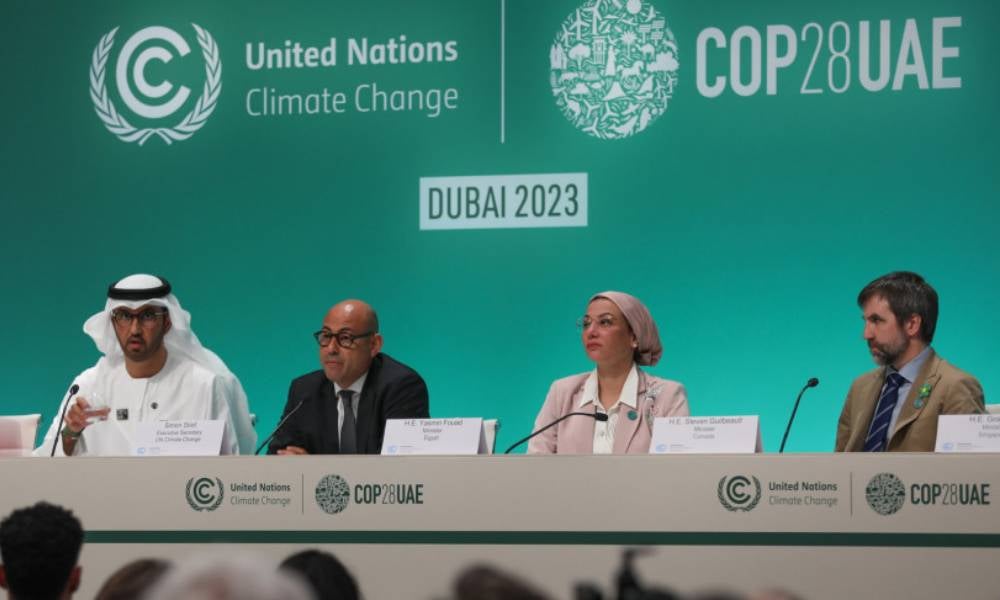Australia’s climate risks and COP28 outcomes for business
A closer look at COP28's outcomes highlights some of the biggest climate risks and opportunities Australian businesses will be presented with this year
The impact of global warming demands immediate action from the Australian government and businesses. At the time of writing, the sea surface temperature up and down the east coast of Australia is 1–3°C above average. Ocean warming contributes to longer and more frequent marine heatwaves, impacting marine ecosystems, habitats, and species like kelp forests and seagrasses. According to the latest IPCC report, the warming climate is fundamentally changing the structure and composition of Australian coral reefs, causing loss of entire ecosystems, increased flood damage, reduced water resources, deaths and infrastructure damage during heatwaves, more fire-related impacts on ecosystems and aboriginal settlements. Australia’s Pacific neighbouring countries are also experiencing some of the worst effects of global warming firsthand.
Australia's biodiversity is not the only thing at risk. Australia’s energy systems must improve to withstand climate risk. The energy transition needed to address climate change affects businesses and, inevitably, future Australian generations. Investments in clean energy and protecting Australia’s unique biodiversity all help, but are Australia's overall climate commitments enough? A close look at the outcomes of the 28th Conference of the Parties to the United Nations Framework Convention on Climate Change (COP28) offers some insights.
COP28 was a major climate change conference held in Dubai, United Arab Emirates, from November 30th to December 13th, 2023. It was the largest COP ever had, with around 85,000 participants, including world leaders, representatives from various sectors, and civil society organisations. The conference concluded the first “global stocktake” under the Paris Agreement, assessing progress on climate action and aiming to accelerate efforts for the upcoming decade. According to UNSW Business School’s Fariborz Moshirian, Director of the Institute of Global Finance (IGF) and an AGSM Scholar, while there weren’t any "breakthroughs", world leaders acknowledged the need for a swift transition from fossil fuels. They agreed on steps to increase ambition and support for developing countries in tackling climate change, discussed concrete action plans, and increased financial commitments to meet the Paris Agreement goals.

Was COP28 a success or failure?
Some significant commitments were made at COP28, including tripling renewable energy capacity and doubling energy efficiency by 2030. Climate finance also took centre stage, with many countries committing significant financial support for climate initiatives such as the Green Climate Fund, the Loss and Damage Fund. There was also a commitment to triple nuclear energy.
COP28 has built on various efforts and commitments made by COP26 and COP27. At COP26, the agreement to phase out coal over time was a major milestone. At COP28, the transition from fossil fuel is another significant step. However, at COP28, one could argue that businesses have been (more than ever) focused on finding real solutions for climate change.
However, the challenge of climate change is one of many other interconnected global challenges facing this generation. The current fragile international order, including the increase in geopolitical tensions, could derail commitments made by COP28.
Further, the commitments made are non-binding; hence, any President, Prime Minister, political party, or the CEO of some major company/ies in power or who will come to power in subsequent months and years could renege on or slow down the commitments and processes.
Finally, there were no significant commitments towards the Global Goal for Adaption. This important policy allows countries to build resilience and contribute to sustainable development.
Read more: Green skills gap: upskilling for climate risk and reporting
How can businesses track progress on their commitments?
A proper mechanism is needed to ensure that each country, mainly developed and emerging, works out its Nationally Determined Contributions (NDCs). This will increase the likelihood that the measures needed to implement the policies of the UN’s first Global Stocktake are both undertaken and sustainable.
This includes creating national, regional, or local policies that create the environment for transformational change in various industries and sectors, including energy, food, transportation, and land use. There is an expectation that countries in their NDCs will identify some of the above policies and measures and submit them before COP30 in 2025.
Beyond headline commitments, what concrete actions are businesses implementing to transition from fossil fuels?
One of the promising signs is that over 50 of the world's largest fossil fuel producers signed an oil and gas decarbonisation charter. This voluntary agreement is to contain and eliminate all methane leaks and stop routine flaring of excess gas by 2030. If the 120 nations that have signed on to multiply renewables put national policies and practices in place for such rapid transformation by 2030, the demand for fossil fuel could decline over time. However, the agreement does not guarantee that this will eventuate promptly.

How can businesses position themselves to thrive in a low-carbon economy?
At COP28, it was encouraging to note that businesses were proactive in identifying ways to cut emissions, using low-carbon technologies, and finding ways to scale up investment in climate action. Businesses are searching for solutions for low-carbon emission industries and sectors.
Business groups are significant contributors towards ensuring that the commitments made by countries, including the US, can be realised over time. Some include new grant funding for Methane Funding Sprint, support for Green Finance Fund policies, and measures to support the idea of triple nuclear energy capacity.
But again, geopolitics is playing an important role, as one can observe that the commitments made by many companies who pledged that they would go away from investment in fossil fuel over time at COP26 have changed since the start of the Russia-Ukraine war.
Domestic politics, including who is or will be the President or Prime Minister or which political party is in power in certain countries, could accelerate or slow down potential momentum phasing out fossil fuel use.
Are there trade-offs for businesses pursuing climate goals and SDG initiatives?
While it is argued that there is often a trade-off between economic growth and the protection of the environment, we have now learned far more about how to manage economic growth and facilitate the emergence of a green economy over time. At the same time, there should be a more holistic approach between the agencies and institutions, including the international development banks and agencies tasked with implementing the policies that create a green economy over time. There could be more synergy between Nationally Determined Contributions and Voluntary National Reviews (VNRs) undertaken by 2030.
Read more: Climate mitigation and resilience: essential skills for future leaders
How can businesses integrate SDGs to address climate change?
Until recently, many businesses, including institutional investors, have been reluctant to commit financial and other support for the SDGs for various reasons. Many traditional business models expected them to be responsible for the highest rate of return to their shareholders, with the least risk and uncertainty. However, there are now some non-traditional mechanisms to encourage the involvement of the private sector, including micro-contributions, public and private partnerships, subsidies, and other financial support.
The use of IT, for example, including access to the internet and the potential use of AI, will require a well-trained workforce in many developing countries. SDGs include objectives such as universal education, the eradication of poverty and the building of adequate infrastructure. These elements influence the capacity of developing countries to put mitigating factors into practice and build climate resilience. More explicitly, goal 13 is about practical measures to combat climate change. Increases in renewal energy are part of SDG 7.2.
Subscribe to BusinessThink for the latest research, analysis and insights from UNSW Business School
What role do businesses play in de-risking and scaling up climate finance investments?
Businesses and institutional investors must ensure they can manage political, technology, regulatory, and market risks. In some developing countries, managing such risks may take a lot of work and a detailed roadmap for addressing the needed energy transition, like reducing greenhouse gas emissions. However, some argue for policy de-risking and financial de-risking.
In this context, development banks, including the World Bank, could act as intermediaries in advancing emissions reductions. This could allow the private sector to spread the overall risk of climate-related initiatives. Other measures seen so far include encouraging the private sector to participate in a climate fund as an equity investor. Public finance, reinsurance, equity, and guarantees protect the private sector’s uncertainty and risks.
Professor Fariborz Moshirian is the Director of the Institute of Global Finance (IGF) and an AGSM Scholar at the UNSW Business School. His latest book is Climate Change and Climate Finance: Current Experience and Future Direction.
